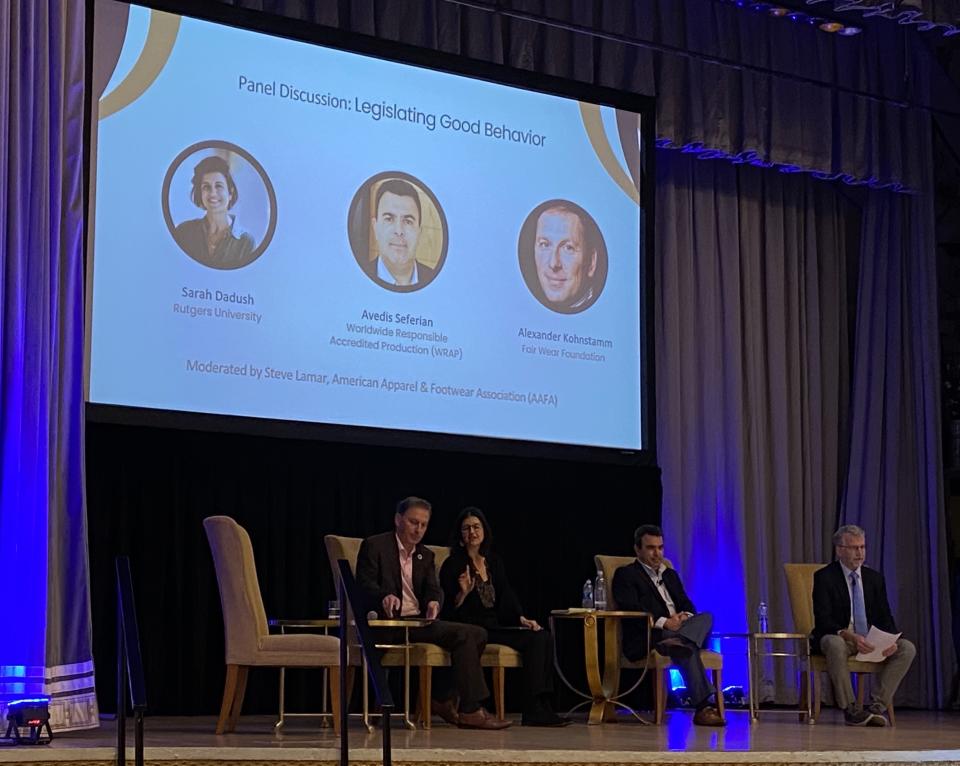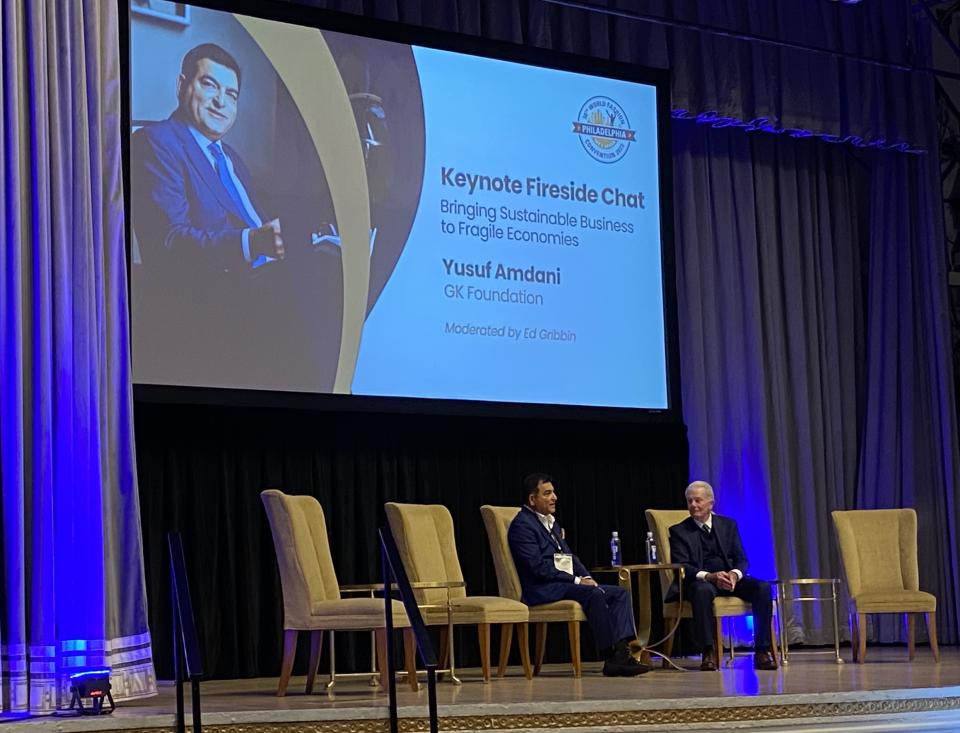At World Fashion Congress, Experts Say Legislation Will Support ‘Good Behavior’

Sustainability expectations for the industry are a constantly moving target, in part due to regulations that turn due diligence from a responsible business practice to a requirement.
During the 38th World Fashion Convention presented by the International Apparel Federation (IAF) and the Sewn Products Equipment & Suppliers of the Americas (SPESA), environmental and social responsibility were common threads throughout multiple talks. Speakers discussed how conventional business practices have already changed, and how they have to evolve going forward.
More from Sourcing Journal
AAFA Urges Cambodian Government to Crack Down on 'Blood Bricks' Trade
US Lawmakers Demand Living Wages for Bangladeshi Garment Workers
“We need to move from large volume production and consumption, to value production and consumption, and minimizing that within planetary boundaries and with giving respect to people,” said Leila Naja Hibri, CEO of The Australian Fashion Council. “There needs to be a seismic and systematic change in the whole industry.”
Legal liability
During a panel on due diligence laws, moderator Steve Lamar, president and CEO of the American Apparel & Footwear Association, said that “good behavior” shouldn’t come from legislation, but rather “moral compass.” However, he sees a role for laws to propel positive change.
“Legislation can and will play a pivotal, critical role in how we move this industry forward…to support the good behavior that is already occurring, to accelerate that good behavior, to make sure those individuals who are not engaging in good behavior are able to be at that minimum level, and that we constantly are raising that level,” he said.
As due diligence legislation changes the legal landscape, supply chain collaboration will be critical in meeting new regulatory requirements. Per Alexander Kohnstamm, executive director of the Fair Wear Foundation, it behooves companies to get their “systems in order,” and they cannot do this alone. He added that manufacturers—particularly Tier 1—should do their own due diligence and be “data partners,” providing additional value in the form of information.
“The nice thing with risk assessment data and knowledge and insights, that’s one of probably the only resources that as you share, it becomes more valuable,” Kohnstamm said. “So you have to share to get ahead.”
Per Avedis Seferian, president and CEO of Worldwide Responsible Accredited Production (WRAP), compliance—including the related data—cannot sit in a silo anymore. Instead, companies should take a more rounded approach to supply chain management.

As part of brand’s due diligence information collection, manufacturers often must undergo multiple different audits since each company has its own system. Seferian noted that there is concern that audit fatigue could grow with increasing legislation, but he foresees it improving the situation. The regulations are calling for audits that are “independent, credible and verified,” which may end the practice of brand-run audits, while also requiring corrective action—something that was lacking in audit-only programs. “You can’t be the fox running the hen house anymore,” he said. “You have to engage independent organizations to validate your supply chain.”
One of the levers to improve human rights is contracts, which establish legal requirements and can help ensure that corporate policies are enacted across the entire supply chain. “They are like an operational manual for the buyer-supplier relationship,” said Sarah Dadush, professor of law at Rutgers University and director of the Responsible Contracting Project. “The way that they tell the parties what to do can actually help build trust or it can cut down trust.”
As Dadush noted, often contracts prioritize a company’s risk factors over human rights risks, and they engage in “risk-shifting,” or pushing risks toward the other party. As an example, contracts frequently require suppliers to maintain perfect compliance. If a vendor finds evidence of wrongdoing in its operations, the desire to keep the business may keep it from disclosing its discovery.
“It incentivizes distrust between the buyer and supplier, and a culture of deception, and possibly pushing the human rights risk further into the shadows of the supply chain, where they’re even harder to address,” Dadush said. If a compliance breach is found, it results in actions such as cancellation of payment or suing suppliers for damages, rather than actions focused on helping workers affected.
“One key one that we hear all the time from suppliers is that buyers want gold human rights standards, but they’re not even willing to pay bronze prices.”
Sarah Dadush, Rutgers University law professor
In 2021, an American Bar Association working group published the MCCs 2.0, which sought to translate OECD guidelines on due diligence and U.N. human rights principles into contractual clauses. Following up on that work, the Responsible Contracting Project is now implementing an open-source toolkit that includes sample contract clauses specifically geared toward the apparel industry. The RCP is guided by principles including a shared commitment to due diligence, remediation that focuses on human rights and better purchasing practices.
“One key one that we hear all the time from suppliers is that buyers want gold human rights standards, but they’re not even willing to pay bronze prices,” said Dadush.
Producing with a purpose
Manufacturer GK has taken up the social responsibility mantle through its GK Foundation. The Pakistan-based company expanded to Honduras in the 1990s, and has provided support to the community there in areas including medicine and education. For instance, an early project involved taking over the external consulting at a public hospital, adding doctors and extending the availability from a half day to a full day. During Covid, the foundation started to distribute meals on a daily basis, an effort that has continued.
Another pillar of GK’s work is education. It has transformed schools, building more classrooms and playgrounds and adding teachers that are on the foundation’s payroll. A parental committee is also created to monitor the education their children are receiving. “For any nation to come out of the poverty, come out of the underdevelopment status, education is a fundamental [priority],” said Yusuf Amdani, chairman of GK, in conversation with SPESA board chairman Ed Gribbin.

GK has also established a “smart city”—a hub for technology companies with LEED buildings and lifestyle centers—providing job opportunities for graduates who received a bilingual education. After noticing that a significant majority of the thousands employed in the smart city had gone to private school, GK decided to transition its 11 sponsored public schools into bilingual learning environments. From a survey the company fielded, graduates of bilingual schools have 200 percent better incomes than those who did not have an English education.
Sustainability was also central to Green Valley, GK’s industrial development. When the company began planning the park 18 years ago, it brought in experts in sustainable urban design. The park will be carbon neutral by 2025, and it has certification for zero waste and ISO’s 14,001 standard for environmental management. GK has also used the infrastructure from Green Valley—such as the wastewater treatment and energy backup—to power services in local low-income housing developments.
Sustainability and cost savings go hand-in-hand, and GK has invested in the latest technology to achieve energy efficiency. “Because our cost of energy is so high, because our labor is much higher than Asia, we need to ensure that we have the most latest technology and the best in the business because we cannot afford to have equipment which consumes higher energy,” said Amdani.
Closing the loop
Another panel delved into a key environmental sustainability topic: circularity.
Circ has developed a process that can separate cotton and polyester blended fabrics into their components, creating a textile-to-textile recycling path. The polyester becomes recycled polyester, while the cotton is turned into lyocell. Julie Willoughby, PhD., chief commercial officer of Circ, compared circularity to services like Airbnb and Zipcar, which allow consumers to use things that already exist in different ways. “We believe you can wear the same clothes for life, your same molecules for life,” she said. “We believe you have all the clothes you need to make all the clothes you’ll ever need.”
By working with brands like Zara, Vivobarefoot and Mara Hoffman, Circ is bringing circular fashion to the masses and creating “market momentum.” “If a brand has power, and a brand is being used as a force for good, [it] can really make a change,” Willoughby said. “We can’t do what we’re doing without a tremendous amount of capital.”
Bryant LaPres, senior director of industry engagement at Apparel Impact Institute (Aii), compared circularity’s “mutual understanding” and collaboration to a group project. “There’s somebody who’s really ambitious, who knows what they want, they want the A. Sometimes you’ve got the person who might be a little bit slacking, they are fine with the C or the D on the project,” he said. “The mutual understanding is you have to get the project done. And then from there, you take this idea of collaboration to understanding your role in the greater good.”
In Australia, governments, industry and organizations have come together to move toward circularity by 2030 and net zero by 2050. This involves considering how goods are made, as well as consumption and recycling. “The whole point of circularity in this industry is to take a whole life approach, and really also change the business model, to convince business to take responsibility, not only for selling items, but also for the end of their life, and how it impacts people and planet,” said Hibri.
Willoughby also noted that the industry must get consumers excited about circularity. “How can we get to the state where we can’t live without circularity?” she said, adding that profitability is also crucial. “That’s what’s going to drive it: It has to be that triple bottom line of people, planet, profit.”

